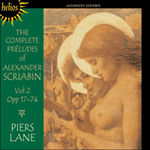Op 17 is far less often performed as a set, but contains some of Scriabin’s loveliest pages. No 1 is a melancholy waltz whose ‘flying’ right-hand line, supported by restless left-hand cross-rhythms, reaches passionate heights. It is the left hand (as so often) of No 2 which provides the motive power, with octave figures across the beat; above floats a magisterial line particularly reminiscent of Chopin. No 3 is in Scriabin’s weightless, filigree manner, and No 4 spins a melodic line over an evenly moving bass similarly to Op 11 No 13, which is in a related key. The scenery of Heidelberg evokes an heroic response in No 5: widespread broken chords in the right hand complement a left hand whose opening gesture anticipates Rachmaninov’s Sonata No 2 of 1913. The ‘doloroso’ marking of No 6 is expressed by ceaseless suspensions, but there is an underlying serenity. These sets often close with a lightweight number, but No 7 is an exception with its long, mobile lines and virtuosic left hand.
from notes by Simon Nicholls © 2001
Moins souvent exécuté sous la forme de recueil, l’opus 17 contient pourtant quelques-unes des pages les plus charmantes de Scriabine. Le no1 est une valse mélancolique dont la ligne mélodique «virevoltante» de la main droite est soutenue par les contretemps agités de la main gauche, atteignant un apogée passionné. Comme bien souvent, c’est la main gauche du no2 qui alimente l’impulsion motivique, avec des sauts d’octaves par delà le cadre métrique sur lequel plane une ligne magistrale suggérant clairement Chopin. Le no3 retrouve le Scriabine de l’immatérialité, du filigrane tandis que le no4 tresse une ligne mélodique sur une basse au mouvement régulier comparable à celle de l’opus 11 no13, lui-même dans une tonalité voisine. Le paysage de Heidelberg évoque une réponse héroïque dans le no5, d’amples mouvements d’accords brisés à la main droite s’associent à la main gauche dont le motif initial anticipe la Seconde Sonate (1913) de Rachmaninov. L’indication agogique «doloroso» du no6 trouve son expression musicale dans des retards continuels, mais ce prélude possède néanmoins une sérénité sous-jacente. Si ces recueils se concluent le plus souvent sur une note légère, le no7, avec ses lignes longues et mobiles, avec sa main gauche virtuose, est bien l’exception qui confirme la règle.
extrait des notes rédigées par Simon Nicholls © 2001
Français: Isabelle Battioni
Op. 17 wird viel seltener von Anfang bis Ende durchgespielt, enthält jedoch einige von Skrjabins reizvollsten Blättern. Nr. 1 ist ein melancholischer Walzer, dessen „fliegende“ Linie für die rechte Hand, unterstützt durch rastlose Gegenrhythmen der Linken, leidenschaftliche Höhen erklimmt. Bei Nr. 2 ist es (wie so oft) die linke Hand, die mit Oktavfiguren gegen den Schlag für Triebkraft sorgt; darüber gleitet eine gebieterische Linie, die besonders stark an Chopin erinnert. Nr. 3 ist in Skrjabins schwerelosem, filigranem Stil gehalten, und Nr. 4 spinnt ähnlich wie op. 11 Nr. 13, das in einer verwandten Tonart steht, eine Melodielinie über einen gleichmäßig dahinschreitenden Baß. Die Szenerie von Heidelberg beschwört in Nr. 5 eine heroische Reaktion herauf: ausgreifende gebrochene Akkorde der rechten Hand ergänzen eine linke Hand, deren einleitende Geste Rachmaninows Sonate Nr. 2 von 1913 vorwegnimmt. Die Bezeichnung „doloroso“ von Nr. 6 drückt sich in unaufhörlichen Vorhalten aus, doch unterschwellig überwiegt Gelassenheit. Die Stückfolgen enden oft mit einer leichtgewichtigen Nummer, aber Nr. 7 stellt mit seinen langen, beweglichen Linien und seiner virtuosen linken Hand eine Ausnahme dar.
aus dem Begleittext von Simon Nicholls © 2001
Deutsch: Anne Steeb/Bernd Müller


 Scriabin: The Complete Préludes, Vol. 2
Scriabin: The Complete Préludes, Vol. 2
